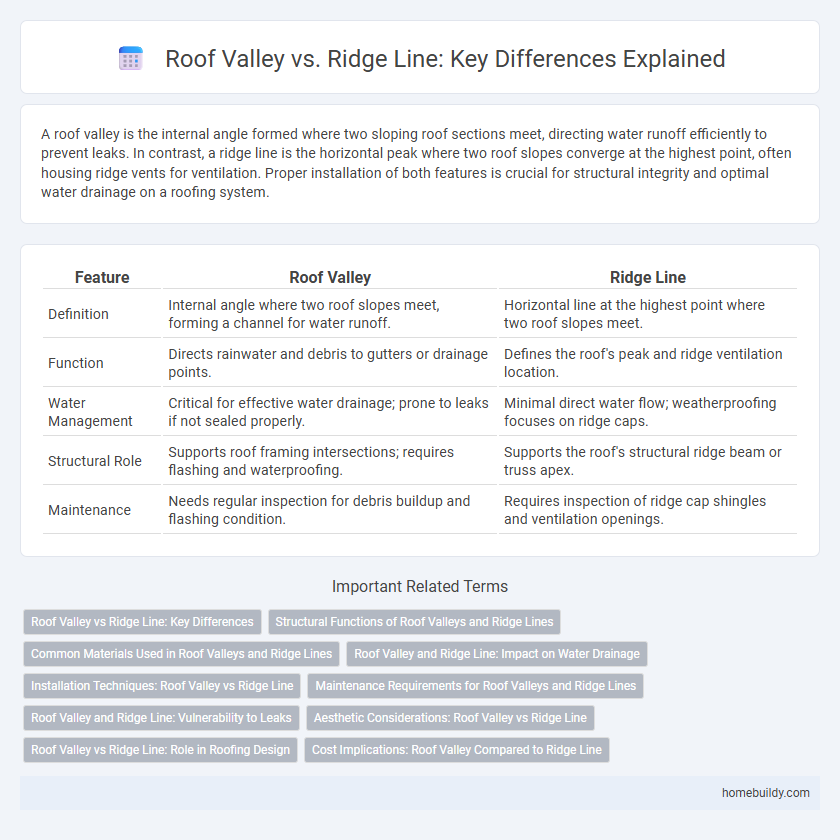A roof valley is the internal angle formed where two sloping roof sections meet, directing water runoff efficiently to prevent leaks. In contrast, a ridge line is the horizontal peak where two roof slopes converge at the highest point, often housing ridge vents for ventilation. Proper installation of both features is crucial for structural integrity and optimal water drainage on a roofing system.
Table of Comparison
| Feature | Roof Valley | Ridge Line |
|---|---|---|
| Definition | Internal angle where two roof slopes meet, forming a channel for water runoff. | Horizontal line at the highest point where two roof slopes meet. |
| Function | Directs rainwater and debris to gutters or drainage points. | Defines the roof's peak and ridge ventilation location. |
| Water Management | Critical for effective water drainage; prone to leaks if not sealed properly. | Minimal direct water flow; weatherproofing focuses on ridge caps. |
| Structural Role | Supports roof framing intersections; requires flashing and waterproofing. | Supports the roof's structural ridge beam or truss apex. |
| Maintenance | Needs regular inspection for debris buildup and flashing condition. | Requires inspection of ridge cap shingles and ventilation openings. |
Roof Valley vs Ridge Line: Key Differences
Roof valleys collect and channel water where two roof slopes meet, creating an internal angle prone to water accumulation and potential leaks, while ridge lines form the highest horizontal line where two roof planes intersect, primarily serving as the peak of the roof. Valleys require precise flashing and waterproofing to prevent damage from water runoff, contrasting with ridge lines that often accommodate ridge vents for attic ventilation. Understanding these differences is crucial for effective roof design, maintenance, and drainage management.
Structural Functions of Roof Valleys and Ridge Lines
Roof valleys efficiently channel water away from intersecting roof planes, preventing leaks and ensuring proper drainage, while ridge lines provide the essential structural support that connects the highest points of a roof, maintaining its overall stability and integrity. The roof valley's design must accommodate heavy water flow, whereas ridge lines often serve as the main axis for roof framing and alignment of rafters or trusses. Both elements are critical for balancing weather resistance and structural strength in complex roof systems.
Common Materials Used in Roof Valleys and Ridge Lines
Roof valleys commonly incorporate durable materials such as galvanized steel, copper, and aluminum flashing to effectively channel water away and prevent leaks. Ridge lines typically use ridge caps made from asphalt shingles, metal roofing, or tile to protect the roof peak while allowing ventilation. Both roof valleys and ridge lines require materials that offer longevity and resistance to weather for optimal roof performance.
Roof Valley and Ridge Line: Impact on Water Drainage
Roof valleys collect and channel large volumes of water, making them critical for effective drainage, especially during heavy rainfall. Ridge lines primarily contribute to water runoff direction but do not gather water like valleys, which are more prone to debris accumulation and potential leaks. Proper design and maintenance of roof valleys help prevent water pooling and damage, while ridge lines ensure smooth water flow across the roof surface.
Installation Techniques: Roof Valley vs Ridge Line
Roof valley installation requires precise cutting and overlapping of shingles to ensure water runoff is effectively channeled away, minimizing leak risks in the intersecting roof planes. Ridge line installation focuses on capping the peak of the roof with ridge vents or shingles that allow for proper ventilation and weatherproofing. Mastery of valley flashing and ridge cap placement is crucial for structural integrity and long-term roof performance.
Maintenance Requirements for Roof Valleys and Ridge Lines
Roof valleys require more frequent maintenance than ridge lines due to the convergence of multiple roof slopes, which increases the risk of water accumulation and debris buildup, potentially causing leaks and water damage. Ridge lines generally experience less exposure to trapped moisture and debris, resulting in lower maintenance needs, but still require regular inspection to ensure the integrity of ridge caps and flashing. Proper cleaning and inspection of roof valleys, especially after storms, are essential to prevent clogs and deterioration, extending the roof's lifespan.
Roof Valley and Ridge Line: Vulnerability to Leaks
Roof valleys collect and channel large amounts of water, making them highly susceptible to leaks due to debris buildup and improper flashing installation. Ridge lines, located at the peak, are less prone to water accumulation but can experience leaks from cracked ridge caps or deteriorated sealants. Proper maintenance of roof valleys is crucial to prevent water infiltration and structural damage.
Aesthetic Considerations: Roof Valley vs Ridge Line
Roof valleys create dynamic visual interest with their angular intersections and shadow play, enhancing architectural depth compared to the more linear and uniform ridge lines. The contrasting lines of roof valleys add complexity to a building's silhouette, often serving as focal points in roof design that break the monotony of standard ridge lines. Ridge lines, while essential for structural integrity and water drainage, offer a cleaner, streamlined aesthetic that complements minimalist and traditional roof styles.
Roof Valley vs Ridge Line: Role in Roofing Design
Roof valleys serve as critical channels directing water runoff between intersecting roof planes, preventing leaks and structural damage. Ridge lines define the highest horizontal edges of a roof, providing the main structural framework and supporting roofing materials. Understanding the distinct roles of roof valleys and ridge lines enhances effective roofing design, ensuring durability and proper water drainage.
Cost Implications: Roof Valley Compared to Ridge Line
Roof valleys generally incur higher costs than ridge lines due to the complexity of their design and the need for specialized flashing to prevent leaks. Ridge lines are simpler to construct and maintain, resulting in lower labor and material expenses. Choosing between a roof valley and a ridge line significantly impacts the overall roofing budget because valleys require more precision and durable materials to ensure water drainage and durability.
Roof valley vs Ridge line Infographic

 homebuildy.com
homebuildy.com